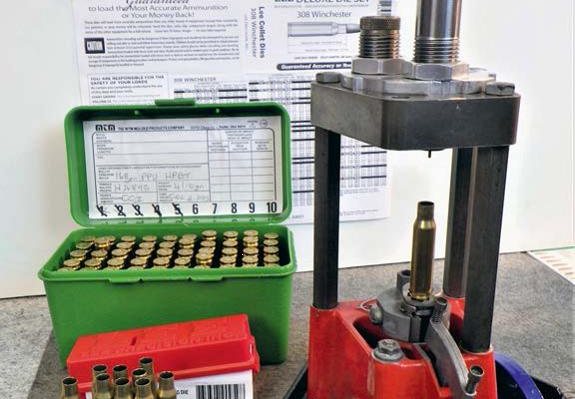Reloading Basics
-
1
 Comments
Comments
- Last updated: 19/02/2022

When a bottleneck case is fired, it expands to fill the entire chamber, then contracts slightly as the pressure drops, allowing the case to be extracted from the rifle. This ability to stretch and spring back is mainly due to the type of brass used for making rifle cases, an alloy referred to as ‘70-30 Cartridge Brass’ (70% copper and 30% zinc). With the enormous pressure involved inside the case, the brass will still soon be ‘worked’ to the point where it will fail. However, the way you resize your brass can have a significant effect on just how soon that failure occurs.
You can take a newly fired case and re-insert it into the same rifle and it will be an exact fit, because it was fire formed in the shape of the chamber. If you plan to reload this case, to be fired again in the same rifle, all you need to do is clean it, re-prime it and reduce the diameter of the neck enough for it to hold a bullet again, leaving the case shoulder and body in the as-fired condition. This process is called neck sizing only.
Cartridges for bolt action or singleshot rifles can be neck sized. Since the case has been fire-formed to a specific chamber, a neck sized cartridge can only be used in the rifle that last fired it. If your ammunition is to be used in a different rifle, you really have to full-length size it instead.
Neck sizing dies are similar to standard full-length sizing dies, except that the only part that contacts the brass is the portion that squeezes and resizes the neck. The part of the die that would normally size the body and shoulder of the case is oversized so that it will not touch the case.
Like a full-length die, the neck sizing die has a combination expander ball/decapping pin which performs the same function as the one in a full-length sizing die. So, the body of the die intentionally undersizes the neck and then the expander ball enlarges it from the inside as it’s pulled out of the case. This allows the die to provide a consistent inside neck diameter, regardless of the thickness of the brass.
A few years ago, Lee Precision changed the design of their collet neck-only sizing die to leave a small portion of the case neck protruding through the end of the sizing collet. This allows the portion of the neck that protrudes above the collet to remain in its fire formed condition, providing a natural flare to the case. This flare allows easier and more concentric seating of bullets and facilitates seating cast bullets or low drag coated bullets without damage. A very clever and useful change.
You might hear of a practice called ‘partial neck resizing’, which uses a regular full-length sizing die that is backed off so that it does not touch the case shoulder during the sizing process. The theory is that a conventional full-length sizing die can be used to resize just the neck, leaving the shoulder and body of the case sized to match the chamber. Don’t do it.
The problem with this method is that even with the die backed off to miss the shoulder, the body of the die will still resize the body of the case, causing the shoulder to bulge upward and so making the case longer. As the cartridge is already at the full length of the chamber, partial neck resizing makes the cartridge headspace length too long for the chamber. You may still be able to get the finished rounds to chamber but if the cartridges are too long, the bolt will be hard to close.
There are several advantages to neck sizing, including longer brass life (more reloads before you have to scrap the cases), no need for lubricant during sizing and less trimming of the brass.
Neck sizing works the brass much less than full-length sizing and this results in less work hardening plus more reloads without splits. When you full-length size, the case’s shoulder is pushed back during the process and this is then reversed when the case expands in the chamber during firing. This process is repeated every time you full length resize the case and will lead to the work hardening and failure.
Also, when you neck size, very little case stretching occurs, so the case walls do not thin out. If there is less case stretch, then there is less brass flow and you will not have to trim the cases as frequently.
You cannot use neck-sized rounds in any firearm other than the rifle that last fired the case. If you use several rifles of the same calibre, then you must keep the neck sized ammo clearly marked as to which rifle can fire it.
There are limits to how many times you can fire neck-sized cases before they expand enough to make chambering difficult, usually after 4 or 5 uses. When this happens, you should full-length size the cases and start the process over again.
In summary, using a neck sizing only die will increase the life of the brass, can speed up the reloading process and produces ammunition that is a ‘best fit’ for your gun. It is well worth experimenting with both full-length and neck-only sized cases to see if accuracy is affected in your gun and if it does not cost you in terms of accuracy, then neckonly sizing is the best option.
